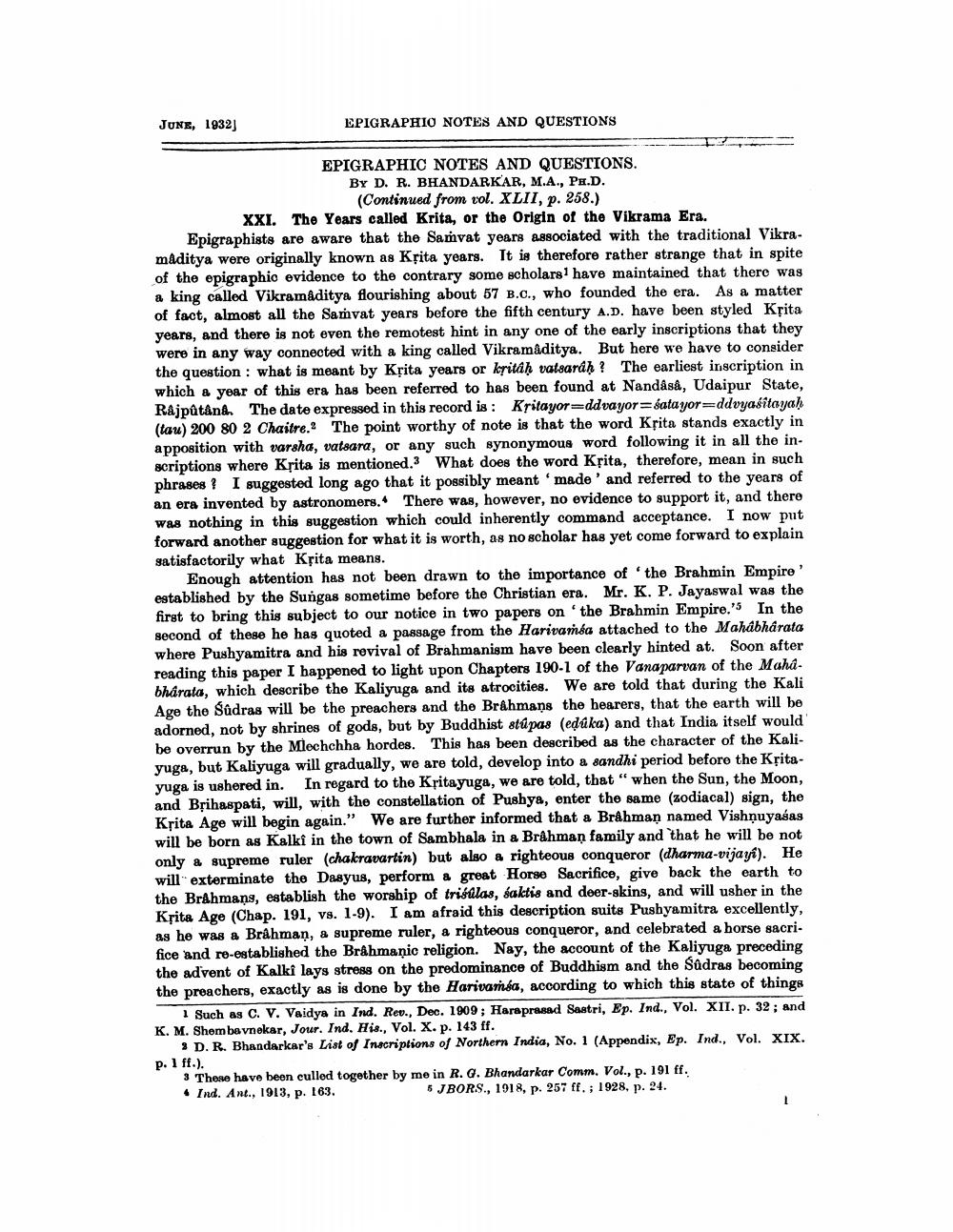________________
JUNE, 1932)
EPIGRAPHIO NOTES AND QUESTIONS
EPIGRAPHIC NOTES AND QUESTIONS.
BY D. R. BHANDARKAR, M.A., PH.D.
(Continued from rol. XLII, p. 258.) XXI. The Years called Krita, or the Origin of the Vikrama Era. Epigraphists are aware that the Samvat years associated with the traditional Vikramaditya were originally known as Ksita years. It is therefore rather strange that in spite of the epigraphic evidence to the contrary some scholars have maintained that there was a king called Vikramaditya flourishing about 57 B.C., who founded the era. As a matter of fact, almost all the Samvat years before the fifth century A.D. have been styled Kpita years, and there is not even the remotest hint in any one of the early inscriptions that they were in any way connected with a king called Vikramaditya. But here we have to consider the question : what is meant by Ksita years or kritäh vatsarah? The earliest inscription in which a year of this era has been referred to has been found at Nandåså, Udaipur State, Rajpûtând. The date expressed in this record is : Kritayor=ddvayor=satayor=ddvya itayah (tau) 200 80 2 Chaitre. The point worthy of note is that the word Krita stands exactly in apposition with varsha, vatsara, or any such synonymous word following it in all the inscriptions where Krita is mentioned. What does the word Ksita, therefore, mean in such phrases? I suggested long ago that it possibly meant 'made' and referred to the years of an era invented by astronomers. There was, however, no evidence to support it, and there was nothing in this suggestion which could inherently command acceptance. I now put forward another suggestion for what it is worth, as no scholar has yet come forward to explain satisfactorily what Krita means.
Enough attention has not been drawn to the importance of the Brahmin Empire' established by the Sungas sometime before the Christian era. Mr. K. P. Jayaswal was the first to bring this subject to our notice in two papers on the Brahmin Empire.' In the second of these he has quoted a passage from the Harivamka attached to the Mahabharata where Pushyamitra and his revival of Brahmanism have been clearly hinted at. Soon after reading this paper I happened to light upon Chapters 190-1 of the Vanaparvan of the Maha. bharata, which describe the Kaliyuga and its atrocities. We are told that during the Kali Age the Sadras will be the preachers and the Brahmans the hearers, that the earth will be adorned, not by shrines of gods, but by Buddhist stúpas (eduka) and that India itself would be overrun by the Mlechchha hordes. This has been described as the character of the Kaliyuga, but Kaliyuga will gradually, we are told, develop into a sandhi period before the Kritayuga is ushered in. In regard to the Kritayuga, we are told, that " when the Sun, the Moon, and Bțihaspati, will, with the constellation of Pushya, enter the same (zodiacal) sign, the Ksita Age will begin again." We are further informed that a Brahman named Vishnuyasas will be born as Kalki in the town of Sambhala in a Brahman family and that he will be not only a supreme ruler (chakravartin) but also a righteous conqueror (dharma-vijayi). He will exterminate the Dasyus, perform a great Horse Sacrifice, give back the earth to the Brahmans, establish the worship of trišalas, saktis and deer-skins, and will usher in the Kita Age (Chap. 191, vs. 1-9). I am afraid this description suits Pushyamitra excellently, as he was a Brâhman, a supreme ruler, a righteous conqueror, and celebrated a horse sacri. fice and re-established the Brahmaņic religion. Nay, the account of the Kaliyuga preceding the advent of Kalki lays stress on the predominance of Buddhism and the Sûdras becoming the preachers, exactly as is done by the Harivamsa, according to which this state of things
1 Such as C. V. Veidya in Ind. Rev., Dec. 1909; Haraprasad Sastri, Ep. Ind., Vol. XII. p. 32; and K. M. Shom bavnekar, Jour. Ind. His., Vol. X. p. 143 ff.
9 D. R. Bhandarkar's List of Inscriptions of Northern India, No. 1 (Appendix, Ep. Ind., Vol. XIX. p. 1 ff.).
3 There have been culled together by me in R. G. Bhandarkar Comm. Vol., p. 191 ff. 4 Ind. Ant., 1913, p. 163.
5 J BORS., 1918, p. 257 ff. ; 1928, p. 24.




